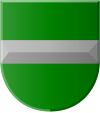Andries Boelens
[3] Boelens is considered the progenitor of the Amsterdam regents of the Dutch Golden Age such as the De Graeff and Bicker families who largely claimed descent and their political legality from him.
[8] He was supported by two brothers-in-law, Ruysch Jan Bethz and Floris Jansz den Otter, who were elected mayor twelve and thirteen times respectively.
Jan van Wieringen Ghijsbertsz believes in his study of the Boelens family that Andries has the right to wear the imperial crown on the coat of arms of Amsterdam obtained, because 'he lent to Emperor Maximilian, a good sum of gelts, by which he received des Emperor's favour, and for the City of Amsterdam, obtained the keyserlijcke crown on her weapons'.
The Dutch poet and writer Joost van den Vondel is the first to speak about the prestigious gift, which does not mean that his statements are wrong, but that no evidence has been found (yet) to support his claim.
In De Inwijdinge van 't Stadhuuis 't Amsterdam, one of the praise and honor rhymes, Vondel suggests a direct connection between the crowning of the coat of arms cross shield and the gout (gold) of the helt (hero) Boelens (who here in poetic freedom of the title Knight is provided).
Waerna Maxmiliaen, Roomsch Koning, hoogh ge-eert, Haer' wapenkruisschilt kroont met diamante straelen, En parlen van zijn kroone, om eeuwighlijck te praelen, Als met een danckbaer merck van zijne majesteit, Voor Ridder Boelens gout, en 's helts grootdaedigheit,[14]In his Amstelodamiana (1874) historian Jan ter Gouw expresses his doubts about Vondel's suggestion that the gold came from Boelen's purse: Vondel poeticized that Amsterdam obtained that crown "for Ridder Boelens gout," but this was already contradicted by his contemporaries.
Had Andries niet Stadts eer bewaert, En 's Keizers glori trouw verdadight, August had met zijn edel swaert Den Ridder spader begenadight, Wiens miltheit Oostenryck behaegt Daer Amstels schilt de kroon afdraagt.


